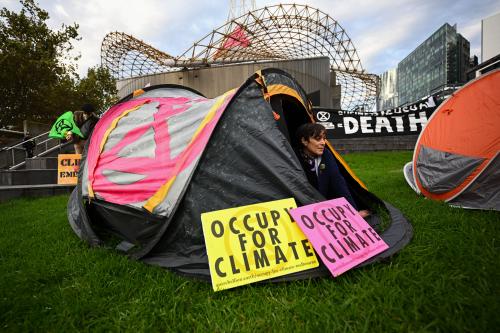This paper was originally prepared for a book compilation for ESADE Business School’s Esadegeo-Center for Global Economy and Geopolitics in June 2019. All content and views in this paper are the sole responsibility of its author and do not necessarily represent the views of Fundación ESADE, the Brookings Institution, or any of their funders.
EXECUTIVE SUMMARY
Greenhouse gas emissions in the United States in 2017 were 13 percent below their level in 2005, the base year for the U.S. Nationally Determined Contribution (NDC) under the Paris Agreement. In 2018, emissions are believed to have risen somewhat, but official government data are not yet available.
Energy use has been falling in the United States, even as the economy has grown. In the last decade, energy use fell 1.7 percent while GDP grew 15.3 percent. In the primary energy mix, fossil fuels declined from 85 percent in 2007 to 80 percent in 2017, while renewable energy (including large hydro) grew from 6 percent to 11 percent. The carbon intensity of the fossil fuel mix declined, with a significant shift from coal to natural gas.
Economics, rather than policy, has been the primary driver of the U.S. emissions decline. The majority of the decline is in the power sector, where advances in domestic natural gas production brought very low prices, allowing natural gas to outcompete coal in power generation. As a result, coal’s share of the generation mix dropped 40 percent and the share of natural gas rose 46 percent over the last decade. Additionally, the share of non-hydro renewables nearly quadrupled over the same time period. U.S. power sector emissions declined 25 percent over the last decade.
Despite this progress, the United States is not on track to meet its NDC. According to some projections, U.S. emissions in 2025 will only be 12 to 20 percent lower than the 2005 levels, falling far short of the target of 26 to 28 percent. The Trump administration is rolling back policies, including those regulating power plants and vehicles, put in place by the prior administration to meet the NDC targets. Furthermore, the Trump administration has announced its intent to withdraw from the Paris Agreement in late 2020, as soon as this withdrawal is allowed. The NDC is not a driver of current policy and the Trump administration is not introducing new policies to reduce U.S. greenhouse gas emissions or further a low-carbon energy transition.
However, the states have more jurisdiction in the power sector, and policies in many states require or encourage low-carbon power. Moreover, following the announcement that the U.S. would be withdrawing from the Paris Agreement, coalitions of state and local governments, business and civil society organizations – such as the “We Are Still In” coalition – formed, with pledges to continue efforts to reduce emissions in line with the goals of the Paris Agreement. A study has shown that if cities and states undertake ten high-impact and readily available opportunities, U.S. emissions could be brought down to 21% below 2005 levels by 2025. The federal level, nevertheless, will remain critical, particularly in vehicle efficiency standards, where the outlook is unlikely to change until the federal government does.







